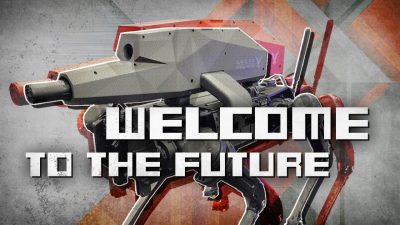Video: Gruesome Warfare and Artificial Intelligence: Robot Dogs with Assault Rifles

All Global Research articles can be read in 51 languages by activating the “Translate Website” drop down menu on the top banner of our home page (Desktop version).
Visit and follow us on Instagram at @crg_globalresearch.
***
The modern battlefield is rapidly changing, mostly thanks to emergent technologies such as robotics and Artificial Intelligence.
Not too-long-ago, infantry had to look for their adversaries on a battlefield, be it in a forest, city or even a cave. Now, troops can simply send in their machines with mounted weapons do their dirty work.
Ghost Robotics is a company known for developing military dog-like robots for several years now. The concept was mostly popularized by Boston Dynamics and their numerous robots.
But at the 2021 Annual Meeting of the Association of the United States Army, between October 11th and 13th, they took things up a notch and showcased their brand-new robot.
The four-legged robot called Q-UGV (quadrupedal uncrewed ground vehicle) had a rifle mounting on top of it.
A gun pod mounted from the center of the robot’s torso has transformed the robot from a strange biomechanical thing to a terrifying chimera. It looks like it came out from a video game.
Although information about the newly-mounted rifle is limited, Ghost Robotics disclosed that the weapon is capable of hitting targets at a distance of 1,200 meters.
The robot also provides impressive stabilization to the rifles because of its quadrupedal design. The rifle could have “some degree of additional autonomy” because it is based on artificial intelligence, which enables the weapon to detect and lock on potential threats.
The weapon also reportedly has a sound suppressor, making it more difficult for enemy soldiers to determine where the shooting is coming from.
In short, the Q-UGV can kill a person from a distance of more than a kilometer, while not revealing where the attack came from.
Robots That Feel the World™ reads the brief display for Ghost Robotics. It describes the machines as “agile & unstoppable ruggedized ground drones with legs” that can be used “for a broad range of military and homeland security applications.”
Those applications, packed into dense jargon-rich phrases, starting with “ISR/Comms,” or intelligence, surveillance, reconnaissance, and communications.
All of these are tasks that a robot dog, equipped with cameras and other sensors, can do well, provided a human operator is on hand with a tablet to receive the communications and scouting.
The Q-UGV is also pitched as useful for patrolling a base, or “explosive ordnance disposal,” and “Chemical, biological, radiological and nuclear defence.”
But the key innovation is the rifle on top of the robot dog, which makes it possible for an operator to control it and attack adversary infantry, or it can function in autonomous mode. The Q-UGV is listed as offering another essential military function: “lethality.”
Starting in 2017, under Secretary of Defense James Mattis, “Lethality” became a focal point of military product marketing. Earlier, weapons manufacturing was focused on allowing users to fulfill their mission. However, ever since then it is much more about the “ultimate goal” – killing people. If possible, according to the “laws of war”.
Back in June 2021, Russia also showcased a robot dog, but it was not equipped with a rifle.
For war, the Russians are focusing on less-complex and, as a result, less mistake-prone systems such as the Uran-9 and the Nerektha which are actively being tested in combat and being used in military operations.
These developments show that warfare is changing towards a more autonomous and robot-oriented fight, with soldiers much less willing to risk their lives in combat, especially performing overseas operations. This is especially evident in Western militaries (and Israel, due to low population) who are rushing to develop unmanned systems of every type.
*
Note to readers: Please click the share buttons above or below. Follow us on Instagram, @crg_globalresearch. Forward this article to your email lists. Crosspost on your blog site, internet forums. etc.
SUPPORT SOUTHFRONT:
PayPal: [email protected], http://southfront.org/donate/ or via: https://www.patreon.com/southfront

